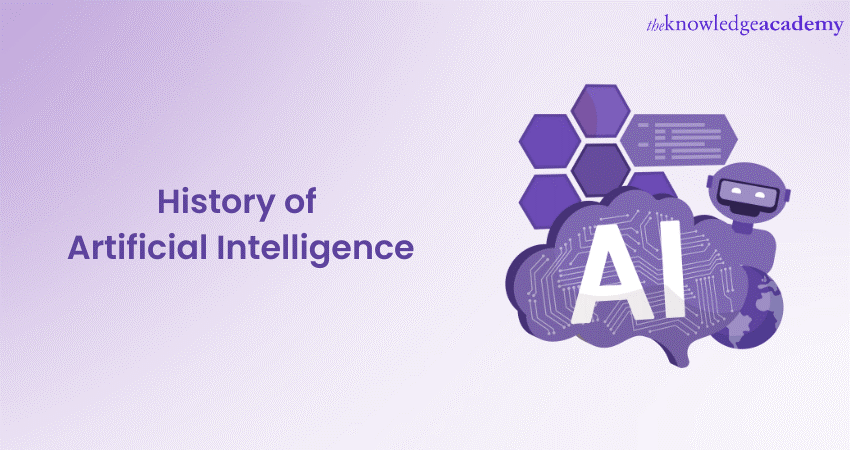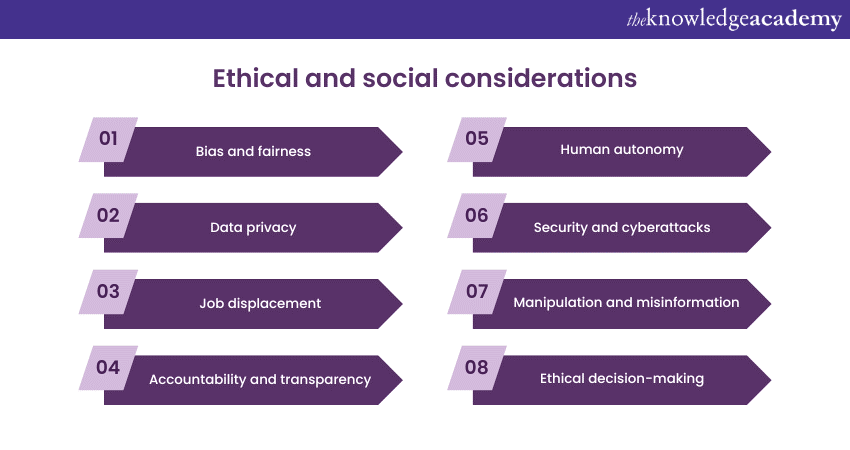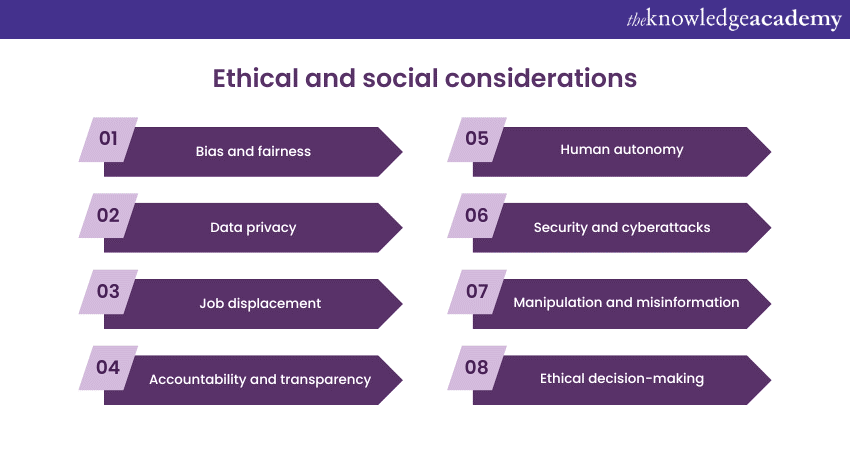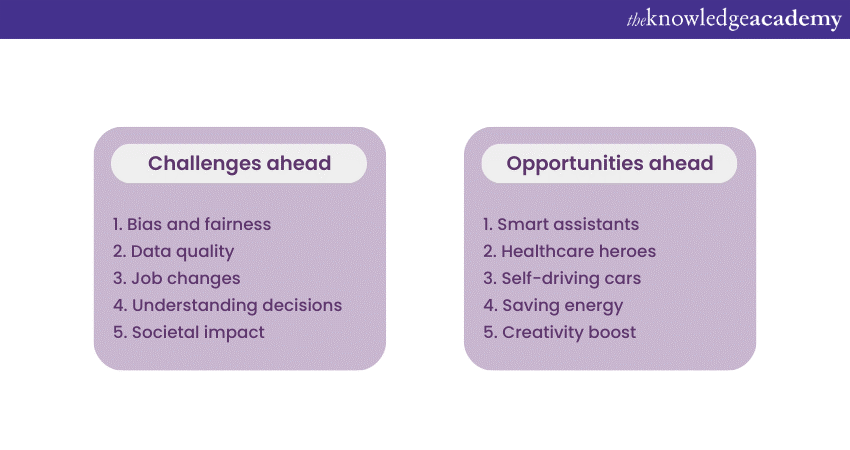We may not have the course you’re looking for. If you enquire or give us a call on 01344203999 and speak to our training experts, we may still be able to help with your training requirements.
Training Outcomes Within Your Budget!
We ensure quality, budget-alignment, and timely delivery by our expert instructors.

Artificial Intelligence (AI) is like giving computers the ability to think and learn like humans. It helps them do tasks that need understanding, problem-solving, and making decisions, just like we do. Figuring out when AI started to exist is a really interesting question to think about, and that is where the History of Artificial Intelligence comes into play.
Artificial intelligence is the simulation of human intelligence by machines. Learn in-depth about the History of Artificial Intelligence and how it came into existence.
Table of Contents
1) The birth of Artificial Intelligence
2) Early concepts and the Turing test
3) The AI winter and expert systems
4) Neural networks and the renaissance
5) Rise of big data and machine learning
6) AI in everyday life
7) Ethical and social considerations
8) Future directions and challenges
9) Human- AI partnership
10) Conclusion
The birth of Artificial Intelligence
The genesis of Artificial Intelligence (AI) can be traced back to the mid-20th century. British-American computer scientist John McCarthy coined the term "Artificial Intelligence" in 1956 during the landmark Dartmouth Workshop. This gathering marked a pivotal moment in history, as it marked the formal birth of AI as a distinct field of study.
The Dartmouth Workshop brought together a group of visionary scientists and researchers. These people aimed to explore the potential of creating machines that could simulate human intelligence. McCarthy and his colleagues believed that by programming computers to mimic human cognitive processes, they could create an era of machines that could reason, learn, and solve problems autonomously.
This early phase was marked by an optimistic atmosphere, as researchers saw AI as the key to unlocking and transforming various aspects of human life. The workshop's participants set out to build computer programs that could play games, understand natural language, and even exhibit creativity.
Dive into deep learning with our Deep Learning Training course – Join today to master AI and machine learning!
Early concepts and the Turing test
During the 1950s and 60s, researchers started exploring the idea of machines thinking like humans. Alan Turing, a British mathematician, proposed a way to measure this with the Turing Test in 1950. This test aimed to determine if a machine could talk in a way that's indistinguishable from a human.
Turing's test sparked discussions about whether machines could truly display intelligence. It questioned whether machines could understand and generate human-like responses. This idea captured people's imaginations and led to important debates about the nature of thinking.
Even though creating machines that passed the Turing Test proved challenging, the concept set the direction for AI research. It encouraged scientists to create programs that could communicate, reason, and simulate human-like abilities. Turing's vision provided a solid foundation for the ongoing development of artificial intelligence, shaping how we perceive and strive to achieve intelligent machines.
The AI winter and expert systems
In the 1970s and 80s, AI faced a difficult period known as the "AI winter." During this time, progress in AI research slowed down due to high expectations that weren't met by the technology of the era. The AI winter occurred because early AI systems couldn't live up to the grand visions set out for them.
Amidst this challenge, a new approach gained attention: “expert systems”. These were programs designed to solve specific problems by using a knowledge-based approach. They relied on rules and information provided by experts in a particular field.
Expert systems marked a turning point by applying AI in practical domains like medicine and engineering. This pragmatic approach helped keep AI research alive during the winter, setting the stage for the later resurgence of the field.
Neural networks and the renaissance
In the late 1980s and 90s, AI experienced a revival marked by the emergence of neural networks. These networks were inspired by the structure of the human brain and aimed to simulate its learning processes.
Neural networks demonstrated the ability to learn patterns from data, which was a significant breakthrough. This sparked renewed interest in AI research and led to progress in fields like speech recognition and image analysis.
During this renaissance, machine learning algorithms also made impressive developments. These algorithms allowed computers to improve their performance through experience, paving the way for practical applications of AI in various industries.
Dive into neural networks and deep learning with our Neural Networks with Deep Learning Training course- Sign up today for enhanced expertise!
Rise of big data and machine learning
As the 21st century began, AI underwent a transformative phase driven by the rise of big data and the evolution of machine learning. The increasing availability of vast amounts of data and improved computing power enabled AI systems to excel in previously unimaginable ways.
Big data played a crucial role by providing the raw material for machine learning algorithms to thrive. Datasets that were once too extensive to analyse manually could now be processed efficiently, enabling AI systems to uncover insights, trends, and correlations that were hidden in the data.
This connection between big data and machine learning had far-reaching implications. It allowed AI systems to become more accurate and capable. It influenced areas ranging from healthcare diagnosis to self-driving cars. As more data became available, machine learning algorithms became more refined, enhancing their performance and applicability.
AI in everyday life
Artificial Intelligence (AI) has seamlessly integrated into our daily lives, impacting numerous aspects of how we interact with technology and the world around us. From the moment we wake up to the time we go to bed, AI is intricately woven into our routines.

Virtual assistants
AI-driven virtual assistants like Siri, Alexa, and Google Assistant have become indispensable companions. They can answer questions, set reminders, send messages, and even control smart home devices, all through natural language processing and understanding.
Personalised recommendations
E-commerce platforms and streaming services employ AI algorithms to provide tailored recommendations. Whether it's suggesting products, movies, music, or articles, AI uses our past interactions and preferences to curate content that resonates with us.
Social media and content curation
Social media platforms rely on AI to organise our feeds, ensuring we see content that aligns with our interests. Additionally, AI-powered content moderation helps filter out inappropriate or spammy content, maintaining a safer online environment.
Healthcare diagnostics
AI assists medical professionals in diagnosing diseases by analysing medical images and data. AI-powered tools can detect anomalies in X-rays, MRIs, and CT scans, aiding in early and accurate diagnoses.

Language translation
Language barriers are bridged by AI-powered translation services. Apps like Google Translate make it possible to communicate effectively with people who speak different languages, breaking down global communication barriers.
Autonomous vehicles
Self-driving cars, an epitome of AI innovation, promise safer and more efficient transportation. AI algorithms process data from sensors and cameras to navigate roads, avoiding collisions and reducing traffic congestion.
Financial services
AI is used for fraud detection and risk assessment in the financial industry. It analyses transactions, detects unusual patterns, and helps prevent fraudulent activities.
Smart homes
AI-powered smart home devices adapt to our preferences, adjusting lighting, temperature, and other settings automatically. These devices learn our routines and respond to voice commands, enhancing our comfort and convenience.
Entertainment and creativity
AI-generated art, music, and writing are becoming increasingly prevalent. Algorithms can compose music, create visual art, and even generate human-like text, blurring the lines between human and machine creativity.
Customer service
Many businesses employ AI-driven chatbots for customer support. These bots can answer common queries, handle complaints, and guide customers through purchasing processes, providing instant assistance.
Ethical and social considerations
The widespread integration of Artificial Intelligence (AI) into our lives has ignited several ethical and social considerations that demand careful examination. As AI technology evolves and becomes more influential, addressing these concerns becomes important to ensure that AI benefits society at large.

Bias and fairness
AI systems often learn from historical data, which may carry biases present in society. If not properly managed, these biases can lead to discriminatory outcomes, reinforcing existing inequalities. Ensuring fairness and mitigating bias in AI algorithms is a critical ethical challenge.
Data privacy
The extensive collection and utilisation of personal data by AI systems raise concerns about privacy. Striking a balance between utilising data to enhance AI capabilities while respecting individuals' privacy rights is an ongoing challenge.
Job displacement
The rise of AI-driven automation has led to fears of job displacement, particularly in industries where routine tasks can be performed more efficiently by machines. Addressing the potential impact on the workforce and creating strategies for reskilling and upskilling is crucial.
Accountability and transparency
As AI systems become more complex, understanding how they arrive at decisions can be challenging. Ensuring transparency and accountability in AI algorithms is essential, especially in sectors where human lives are at stake, such as healthcare and autonomous vehicles.
Human autonomy
As AI systems become more capable, questions arise about the extent to which they should make decisions on behalf of humans. Preserving human autonomy and control over AI systems is an ethical concern that demands attention.
Security and cyberattacks
AI can be exploited by malicious actors for various purposes, including crafting more sophisticated cyberattacks. Developing robust AI security measures to protect against such threats is a priority.
Manipulation and misinformation
AI-powered deepfakes and other manipulation techniques can be used to spread misinformation and deceive people. Combating the misuse of AI for propaganda and fake content is a pressing social challenge.
Ethical decision-making
Designing AI systems to make ethical decisions is a complex task. Determining universal ethical guidelines and embedding them into AI algorithms requires interdisciplinary collaboration and careful consideration.
Master Deep Learning with our Deep Learning With TensorFlow Training course– Join now for in-depth training!
Future challenges and directions
Imagine a world where computers can think, learn, and even make decisions like humans. This is the exciting realm of Artificial Intelligence (AI), where machines are trained to understand and solve complex problems. As AI becomes a bigger part of our lives, there are some challenges we need to tackle and exciting possibilities that lie ahead.

1) Bias and fairness: Sometimes, AI systems can unknowingly learn biases from the data they are trained on. Just like people can have unfair opinions, AI can also make unfair decisions if it learns from biased data. We need to make sure AI is fair to everyone, regardless of their background.
2) Data quality: AI needs lots of information to learn from. But if the data is incorrect or incomplete, it can lead to wrong conclusions. Getting good quality data that represents all kinds of situations is a big challenge.
3) Job changes: AI can be super helpful, but it might also change the types of jobs people do. Some tasks that are repetitive and can be done by machines might be done by AI, which could affect certain job roles. We need to think about how to prepare for these changes and make sure everyone can find meaningful work.
4) Understanding decisions: Sometimes, AI makes decisions that are hard for humans to understand. This can be a problem, especially in important areas like medicine or self-driving cars. We need AI to explain why it made a certain decision, so we can trust it better.
5) Societal impact: AI's impact on social dynamics, culture, and human relationships requires careful consideration to avoid unintended consequences.
At the same time, there is a bright, revolutionary future ahead for AI to bring unimaginable changes.
1) Smart assistants: Imagine having a smart friend who can help you with anything, from finding recipes to answering questions. AI-powered virtual assistants like Siri and Alexa are just the beginning. In the future, they might help us organise our schedules, remind us of important tasks, and even give us advice.
2) Healthcare heroes: AI could help doctors diagnose diseases faster and more accurately. By analysing lots of medical data, AI might spot patterns that humans can't. This means quicker treatments and better health for all.
3) Self-driving cars: Imagine sitting in a car that drives itself! Self-driving cars are being developed using AI to navigate safely on the roads. This could make driving safer and reduce accidents caused by human errors.
4) Saving energy: AI can help us use energy more wisely. Smart systems could adjust our home temperatures when we're not there, saving electricity. AI can also predict when machines need maintenance, preventing energy wastage.
5) Creativity boost: AI can assist artists, musicians, and writers by suggesting new ideas. They could even create new songs or art pieces based on what they've learned from existing works.
Enhance your IT expertise with the Artificial Intelligence (AI) For IT Professionals (AI4IT) course by The Knowledge Academy!
Human- AI partnership
In this partnership, AI augments human capabilities by performing tasks that are time-consuming, repetitive, or data-intensive, allowing humans to focus on more creative and complex aspects of the task. For instance, AI can quickly analyse large datasets and provide insights, which humans can then use to make informed decisions.
On the other hand, humans provide the context, emotional intelligence, and critical thinking that AI lacks. They guide AI's learning process, ensuring it aligns with human values and ethics. This synergy creates a symbiotic relationship where both parties complement each other's weaknesses and strengths.
Examples of the Human-AI partnership can be seen in various fields. In healthcare, AI aids in diagnosing diseases, while doctors interpret results and decide on treatment plans. In creative industries, AI generates ideas, and humans refine and bring them to life.
Conclusion
The History of Artificial Intelligence is a tale of innovation and evolution. From its early beginnings as a concept to its current role as a transformative force, AI has come a long way. As we move forward, the ethical considerations and the potential for a harmonious human-AI partnership will guide the direction of AI's future trajectory.
Supercharge your skills with AI and Machine Learning – Check out Artificial Intelligence & Machine Learning courses today!
Frequently Asked Questions
Upcoming Data, Analytics & AI Resources Batches & Dates
Date
 Introduction to AI Course
Introduction to AI Course
Fri 24th Jan 2025
Fri 28th Mar 2025
Fri 23rd May 2025
Fri 25th Jul 2025
Fri 26th Sep 2025
Fri 28th Nov 2025







 Top Rated Course
Top Rated Course


 If you wish to make any changes to your course, please
If you wish to make any changes to your course, please


